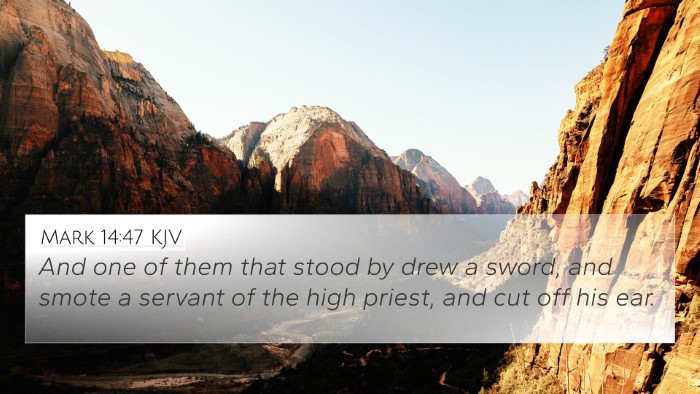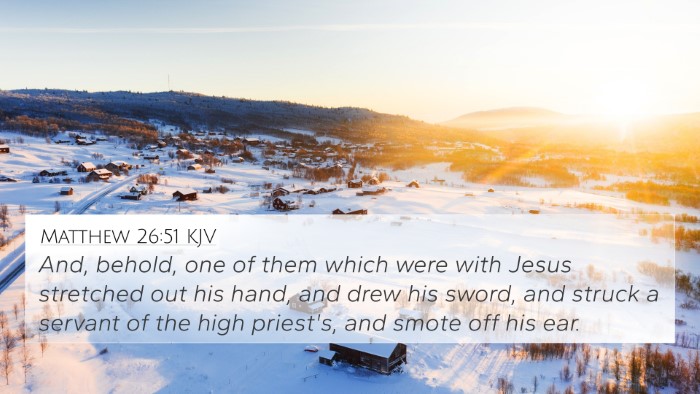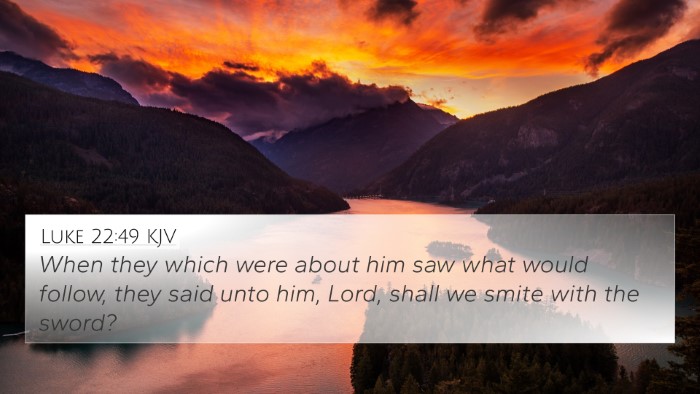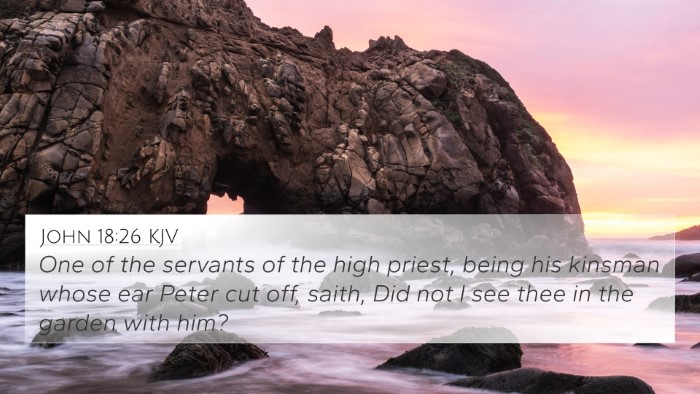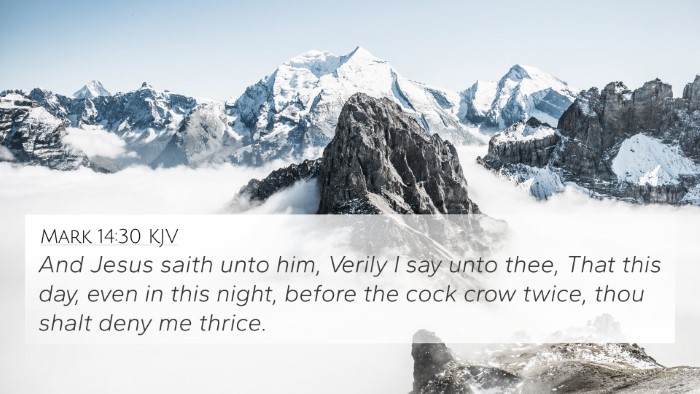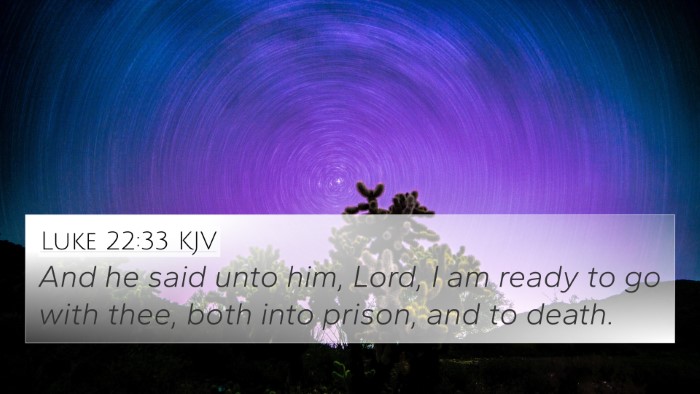Meaning and Interpretation of John 18:10
John 18:10 states: "Then Simon Peter having a sword drew it, and smote the high priest's servant, and cut off his right ear. The servant's name was Malchus." This verse takes place in the context of Jesus' arrest in the Garden of Gethsemane and is a profound illustration of human emotion, impulsiveness, and the events leading to the crucifixion of Christ.
Context and Background
This incident occurs as Jesus is being betrayed by Judas and arrested by the Jewish authorities. It is a specific moment that highlights the tension between the divine mission of Jesus and the actions of His followers. Peter's reaction can be understood in light of several themes present in the Gospels, including loyalty, violence, and misunderstanding of Christ's mission.
Commentary Insights
Matthew Henry's Commentary
Matthew Henry notes that Peter's action is a mix of courage and misguided zeal. Peter grabs his sword in defense of Jesus, exemplifying his loyalty. However, Henry emphasizes that this violence was contrary to the spirit of Christ's teachings, indicating that the kingdom Jesus came to establish was not one of physical force. Henry also points out that the incident culminates a series of moments where Jesus' followers struggled to comprehend His purpose.
Albert Barnes' Commentary
Albert Barnes focuses on the character of Malchus, the servant who lost his ear. He highlights that while Peter's intentions were protective, the result of his action was destructive. Barnes underlines the futility of using physical means to protect the spiritual mission of Jesus. He further suggests that this act of violence was a momentary lapse for Peter, reflecting the disciples' general confusion about the nature of Jesus' kingdom.
Adam Clarke's Commentary
Adam Clarke adds depth by exploring the significance of the right ear being cut off, suggesting that it symbolizes the attempt to silence those who oppose the truth. Clarke emphasizes that Peter’s action not only was an impulsive response but also served a greater purpose in the unfolding of Jesus' sacrificial mission. He also notes that Jesus' reaction to heal Malchus' ear demonstrates His commitment to peace and reconciliation even in the face of betrayal and violence.
Thematic Connections
This moment links to broader biblical themes such as:
- The Nature of True Discipleship: Following Christ often involves self-denial and peace rather than taking up swords as seen in Matthew 26:52.
- Fulfillment of Prophecy: This incident is pivotal in the narrative of Jesus' passion as foretold in Isaiah 53:5, illustrating the suffering servant's mission.
- The Role of Peter: This highlights Peter's impetuous nature, which is elaborated on in other passages (e.g., Galatians 2:11).
- Divine Authority over Human Actions: This event underscores God's sovereignty even amid chaos, as reflected in Proverbs 21:1.
- Healing and Restoration: Jesus’ act of healing Malchus represents divine restoration and forgiveness, echoed in Luke 6:36.
- Spiritual vs. Physical Warfare: Paul echoes this distinction in Ephesians 6:12, reminding believers that our battle is not against flesh and blood.
- Forgiveness and Mercy: This incident sets the stage for the grace and forgiveness that Jesus later extends, as seen in Luke 23:34.
Bible Cross-References
John 18:10 connects with several other verses in the Bible:
- Matthew 26:51-54 - Peter cuts off the ear, and Jesus instructs him on peace.
- John 18:36 - Jesus clarifies the nature of His kingdom.
- Luke 22:49-51 - The same account detailing Jesus healing Malchus.
- Isaiah 53:2-5 - Prophecies about the suffering servant.
- Matthew 5:39 - Jesus' teachings on non-retaliation.
- 1 Corinthians 2:8 - The rulers of this age did not understand God's plan.
- Ephesians 6:12 - Our struggle is spiritual, not physical.
Concluding Thoughts
John 18:10 serves as a reminder of the struggle between human impulse and the divine mission. It provokes reflection on how modern believers react in times of crisis. While Peter acted in protection of Jesus, the context teaches us about the importance of understanding and following the teachings of Christ, aligning our actions with the principles of love and peace permeated throughout scripture.
Tools for Bible Cross-Referencing
To explore the depth of connections between Bible verses, consider employing tools such as:
- Bible Concordance - A useful tool for finding keywords and their occurrences throughout the Bible.
- Bible Cross-Reference Guide - Lists various cross-references for thematic study.
- Bible App Features - Many applications and software provide instant cross-references.
- Annotated Bibles - These often include marginal notes that point readers to related verses.
- Interlinear Bibles - Helpful for studying original texts alongside translations.
Final Reflection
In understanding John 18:10, one can appreciate the broader narrative of the Gospel, illustrating the tension of human action in light of divine love and purpose. The power of cross-referencing and studying related verses allows believers to dive deeper into their faith, creating a rich tapestry of understanding that spans both the Old and New Testaments. This verse exemplifies the need for discipleship that resonates with peace, love, and a commitment to divine principles.



